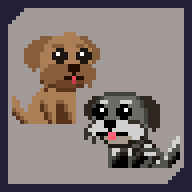Judi-n-Lyle Devlog - 001
It’s been a hot minute since the last post and I wanted to talk about some of the things I’ve been working towards. I don’t have much to show from the classic “productivity” sense with respect to concrete output and things moving on the screen. However, I have been spending a lot of time in the planning phase. I think this phase is sort of understated and overlooked by solo developers who often value work and productivity from a raw output wrt lines of code or assets created, but we need to make sure we actually understand what we are building. Often, this outlook on work and productivity leads to burnout and toil as the pressure for writing more code and systems is overtaking the phase of stepping back and roadmapping to a more successful finish line. This is something I’ve discussed in depth with my fellow game dev friend. So I am practicing that skill and working towards making sure I am building the right thing for myself that I will be proud of. Anyways, mini rant over, let’s get to the fun output and show you what I’ve got.
The biggest thing I have right now in terms of Judi-n-Lyle is setting up a project in Linear which is an amazing project management tool I have been recently using in my professional software career. I went through an exercise to plan out and shape work for myself with the initial final goal in mind of having a playable demo for Judi-n-Lyle to showcase the vision and atmosphere of the game. I would love to get some raw feedback from potential users to understand if I am making a game that would be enjoyed by many, or whether it would be just for myself. I also have it in mind that while I would love to make some money on this experience, but that is not explicitly why I am doing this journey. I want to make something that I am proud of, but along with that, I want to make something that other people would also love to play.
For this prototype, I went through and identified the following “pillars/vertical slices” of work I need to accomplish.
| Judi and Lyle Character Controllers | 2 Levels: Design and puzzle mechanics | Environment art |
|---|---|---|
| Design initial controller contraints | Determine Level + Character constraints | Tilemap or other for ground + platform interactions |
| Design and define special abilities for Judi and Lyle | Gray-box design the structure of each level | Basic Parallax backround generic trees |
| Create animations for special moves | Determine 3 Puzzle Types | Various prop design (make the atmosphere come alive) |
| Refine character swapping mechanic (play around with slomo) | Design for enemy mechanics on how to evade/attack |
| Post Processing + VFX | SFX | Basic Music Concept | GUI/UI + Menus | Enemy Design |
|---|---|---|---|---|
| Create a list of VFX to implement | Create a list of SFX to implement | Decide if making myself or outsourcing | Main menu UI design | Design 2 enemies |
| Setup basic Post Processing stack (bloom, vignette, etc.) | Judi + Lyle Barking + various noises | Set budget for music or use royalty free | Pause menu UI design | Enemy art assets |
| Known VFX: Leaves falling + rustling Footprint dirt rustling | UI SFX | HUD Design | ||
| Ambient Sounds | Credits + Thank you screen |
I am a very ambitious person, but I also want to be realistic and kind to myself. I know that I have a great deal of skills, but creating music is not one I currently possess. That area is something I am considering using other sources for and maybe I will come back and learn to make some fun chiptune music myself. However, I understand how crucial music is to a videogame experience, and I also understand that realistically for a prototype to be successful in a reasonable timeframe, I will just have to accept my limitations and focus on getting other things done first that matter more to me.
I have also gone through these vertical slices and prioritized components that are most important and block other ones such as the following.
- Determine Level + Character Constraints
- Determine Puzzle Formats/Types
- Design Initial Contraints for Levels + Characters
I am working from a mindset of “I need to define and understand my design constraints for levels and characters in order to make a more cohesive experience.” That is one thing I learned from my experience making a puzzle game, Electriload for the Godot Wild Game Jam. The important lesson learned there is that I chose an incredibly specific set of puzzle constraints for myself and that made it clear for how I designed levels. Once I made those distinctions, I could whip out 10 levels in hours instead of spending more brain energy deciding new potential mechanics everytime I had a fresh idea. Ideas are cheap, but can be expensive in the long run if it weighs down the time spent actually developing.
Take the time to slow down, take a step back, assess what you are building and why. This will hopefully make all the difference for me in this project.
Thanks again for reading! Hope to see you again very soon :)
